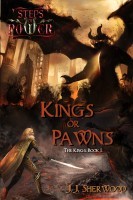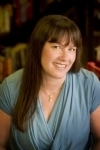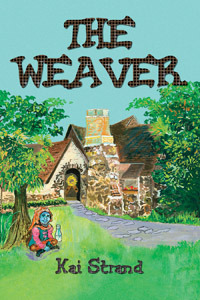Mayra Calvani's Blog - Posts Tagged "elves"
A Lyrical Tale, a Little Magic, and a Lot of Storytelling
Kai Strand is a middle grade and young adult author. She lives in Central Oregon with her husband and children. They love to hike and geocache. She reads every story she writes to them. They are amazingly patient and remain appropriately enthusiastic. Kai has had several short stories published online and in print magazines. You can find links to some on her website. To learn more about Kai and her writing, visit www.kaistrand.com
About the book: In the town of The Tales, people communicate through stories. They call themselves word weavers. Mary Wordsmith is the daughter of the most revered word weaver of them all, yet she suffers through her third year of Novice Word Weaving. Mary thinks her troubles are over when she meets a gnome-elf who grants her a wish. But instead of weaving a better story, she's weaving strange yarn charms to accompany her still pathetic tales.
The Weaver is a lyrical tale with a little magic and a lot of storytelling. It is a finalist in the EPIC eBook Awards. Written for children 9 - 12 years old, but enjoyed by people of all ages.
I understand you wrote short fiction for magazines before you started writing full-length novels. How did the transition come about? Were these short stories for children?
Actually, I did start with novels, or rather a novel. My first novel came out of me and into the computer in an unusually fast pace. In fewer than two months, I created an epic middle grade fantasy of 85,000 words. I realized that might be a bit too long, but cutting all those clever words of mine proved difficult. I turned to short stories 1.) to keep me creating and happy while I edited – not my favorite part of writing and 2.) to learn economy of words. I dabbled in picture books for the same reason, but I’ve given up on picture book text for now. Eventually I trimmed that first novel down to 70,000 words, but it too is shelved for the time being.
Most of my writing is for children, though it used to be personal. For years I created poems or short prose for friends, coworkers or my husband as gifts. I’d print them on pretty paper, frame them and wrap them up fancy. Personalized and handmade gifts are so much fun to create (and receive).
What makes you passionate about writing for children and when did this passion begin?
Writing for children happened because I have four of my own. I don’t think I was very good at being a kid, myself, so when my children came along and showed me how much fun it could be, I learned to appreciate everything “kid.” Then when they started to read, it sort of unlocked my memories of how books helped steer my growth and maturity. I guess I hadn’t realized how important what you read is to your decision making abilities until I started seeing children’s books through my adult eyes. Suddenly I hungered to provide examples of how to have fun, how to play, how to be good at being a kid.
My ultimate goal with my writing is to provide a child an escape hatch from their reality. I want them to climb into someone else’s life where they don’t feel pressured to act nice or choose right from wrong. I want them to just piggyback the main character and imagine what it would be like to experience new and different things.
Congratulations on the publication of your middle-grade novel, The Weaver. What inspired you to write it?
Thank you. The Weaver was inspired by the name of my online critique group, Silver Web. I was sitting in front of my computer one day, casting around inside the cobwebs of my mind for a story idea. I had the main page of my critique group on my screen and we have this awesome web graphic. I thought, “Spiders weave webs like we weave stories. We’re word weavers.” That thought grew into me imagining living in a town where people speak in story.
Tell us something about your protagonist, Mary. What kind of girl is she and why do you think young readers will love her?
Poor Mary is suffering through her third year of Novice Word Weaving. At eleven years old, she stands head and shoulders taller than her eight year old classmates. To make matters worse, her mother is the most revered word weaver in town. When Mary meets a strange little creature that grants her a wish, she thinks her troubles are over. Except instead of weaving a better tale, she is weaving odd little yarn charms to accompany her still pathetic tales.
I wanted to create a character that wasn’t really different from her friends, but felt like she was nonetheless. I suspect that “not fitting in” is one of the number one worries of children (and many adults) so I think they will relate to poor Mary who worries that being an inept storyteller makes her stand out like a sore thumb. And they should really feel her plight when she is suddenly knitting strange yarn charms, which really do make her different.
What about the antagonist?
I want to continue to describe Mary here, but that wouldn’t be right, would it? However, there isn’t a direct antagonist in the story. Mary has two loving parents and very supportive and loyal friends. Even the odd little gnome-elf, Unwanted, tries to help her. She really is her own worst enemy.
Do you have a writing routine or any quirks, such as meditating, listening to music or some other thing?
I suppose I have several ways to circumvent monotony. If I have writer’s block, I read a book on the writing craft, which ALWAYS unsticks me. If I’m struggling with a pathetic lack of creativity, I change my location; tryout a new coffee shop, write at the library or a park if the weather is nice. Sometimes I listen to music, but it has to be instrumental only and preferably something I’m not too familiar with, otherwise I end up losing myself to the notes, the chords, the harmonies, the dissonance. I really love music.
I’d love to hear about the writing process for this novel. How long did it take you to write it? How many times did you edit it, etc.?
Please note that I am blushing while typing this. I can’t answer those questions. I don’t remember when I started this book. I wrote about ¾ of it and then got side tracked. I wrote a whole other novel before coming back to this one. It sat around for maybe a year. Anyway, the irony behind this story is that I stepped away from it when I couldn’t figure out how to bridge from the middle to the end. Eventually, I scolded myself because I had this perfectly good manuscript collecting dust on my hard drive. I told myself, “Just sit down and do the hard work.” In the end, that was the bridge my character needed in her story arc. She needed to sit down and do the hard work.
I don’t even remember how many passes I made during the editing process, but I know it is a very different book from its original form. I don’t use an outline so often my stories will head in a different direction than I originally intended. During editing I decide which I like better and rewrite accordingly.
Do you have any tips for aspiring children’s authors?
Love what you do and remember why you love it. Becoming a published author is difficult and discouraging, but don’t get caught up in that.
Read a lot of books written for the age group you want to write for. Immerse yourself in the text. Read so much you start talking like that or you dream it.
Writing a lot is important, but without good, objective feedback you probably won’t improve much. Find a critique group or partners that understand the genre and age you are writing for and that will point out the good and the bad and make suggestions on how to fix it. Then return the favor. You learn so much when you critique someone else’s work.
Is there anything else you’d like to share with my readers?
I’m thrilled to announce the sale of my middle grade novel, Save the Lemmings! to Featherweight Press. When Natalie’s Texty-Talky invention makes her an overnight sensation, the media digs until they find a way to smear her goody-goody image.
Look for publication in 2012.
Please visit my website and like my author page for more writing related news. Thanks for reading!
Thank you, Kai!

Published on December 07, 2011 01:22
•
Tags:
elves, gnomes, kai-strand, middle-grade-fantasy, the-weaver
Interview with JJ Sherwood, Author of 'Kings or Pawns'

 On a cold winter night, wind howling into the desert sky, one ordinary hospital gave witness to a historic event. JJ Sherwood was born at 2:30 a.m. on December 31st, just barely managing to squeeze in to supplant New Year’s Eve. JJ has always had a flair for the dramatics.
On a cold winter night, wind howling into the desert sky, one ordinary hospital gave witness to a historic event. JJ Sherwood was born at 2:30 a.m. on December 31st, just barely managing to squeeze in to supplant New Year’s Eve. JJ has always had a flair for the dramatics.Sherwood began writing in the womb after a harrowing incident in which Mother Sherwood swallowed a pen—and thus, destiny was born. JJ’s first work was completed by the age of 5: a riveting tale of a duck attempting to climb into an apartment during the pouring rain. Unfortunately this book is not in print, but it served as the first spark that spurred on a lifetime of creativity.
Much of JJ’s childhood was spent tearing through the woods, playing out fantasy worlds, and tying Barbie to the roof so that the Power Rangers might rescue her. Middle and high school carried on this roleplaying, while college encompassed creating and refining over 250 characters in the world of Aersadore.
After escaping college, finally armed with the tools of the trade and a lifetime of development, JJ set to writing what would become the Steps of Power series: it was then that Eraydon slew his first dragon, Jikun battled the warlord Saebellus, and Taranus rebelled against his brother’s throne.
When not orchestrating the lives and deaths of the people of Aersadore, JJ’s hobbies include drawing, video gaming, wearing a bathrobe, and eating too many baked potatoes. JJ Sherwood lives in Cincinnati, Ohio with one loving and extremely patient spouse, a bearded dragon, a monk parakeet, and four cats who look far too similar.
Q: Congratulations on the release of your book, Kings or Pawns. To begin with, can you gives us a brief summary of what the story is about and what compelled you to write it?
A: As with any intrigue/suspense, the less you know, the better. The story is about an elven nation riddled with corruption and balanced on the brink of all out war with enemy warlord Saebellus. I have always loved the fantasy genre but have been disappointed by the lacking number of fantasy books geared for adults. Having grown up on Dragonlance, I always hoped to find a series as large and complicated, full of strong characters, set in a rich world, well-written, engaging, and enthralling—but geared for adults. So that’s what I write now.
 Q: What do you think makes a good fantasy? Could you narrow it down to the three most important elements? Is it even possible to narrow it down?
Q: What do you think makes a good fantasy? Could you narrow it down to the three most important elements? Is it even possible to narrow it down?A: Easy, actually: world-building, realism, and strong characters. I love the fantasy genre, and I believe those three things make or break fantasy.
World building is the scope, history, development, and strength of the world where all of the events and characters take place. Tolkien is a great example of a massive, fully developed history and world that allows readers to delve into a series and find themselves wonderfully lost within the depth of the world—and hungering for more.
Realism is the careful balance between fantasy and believability. In my case, I focus on realism to ensure non-fantasy readers can pick up and fall in love with the book. Even the magic systems—while retaining airs of fantasy— have a foundation of scientific understanding.
Strong characters is the last and possibly most important element—characters who rise above stereotypes and embed themselves into your memory… characters who drive and shape the story by their faults and strengths, heroics and mistakes. Characters whom you can fall in love with.
Q: How did you go about plotting your story? Or did you discover it as you worked on the book?
A: I plotted my story from bullet-point to bullet-point, but as the characters fully drive and shape the story, elements very often shift away from my original plan as characters argue that they “would not have done something quite that way”—and that single shift causes a ripple effect throughout the entire story ’til the end.
Q: Tell us something interesting about your protagonist and how you developed him or her. Did you do any character interviews or sketches prior to the actual writing?
A: There are multiple points of view and multiple protagonists, but I’ll address General Jikun—as his visage is most seen in our series artwork. Jikun was always an arrogant, cynical individual—just since the moment I began thinking he shaped himself that way—and I find once I write the first sentence of a character’s existence, the rest just… materializes and carries forward as though he’s always been a complete and full individual. I have little control over how the characters “create themselves.”
Q: In the same light, how did you create your antagonist or villain? What steps did you take to make him or her realistic?
A: Antagonists/villians have long since been some of my favorite individuals. I find that the most interesting and REAL characters are those that are not “good” or “evil” per se, but rather those characters who have “both traits.” Thus, my antagonist is simply an individual on one side of the coin, with admirable traits and flaws, making him an understandable, complicated, and interesting individual—and I prefer the same thought process with my “good” characters as well, including the aforementioned General Jikun.
Q: How did you keep your narrative exciting throughout the novel? Could you offer some practical, specific tips?
A: I wrote from several points of view and I focused on each point of view as being distinct and entertaining. For example, when writing from General Jikun’s point of view, I infuse a lot of dry humor, cynicism, and metaphors into the writing—readers know they are getting a skewed but unique view of events/characters/the world. Then the next point of view might be from the mute servant girl, Alvena, who is spunky, bubbly, and very optimistic—a stark opposite to General Jikun and a new, fresh look at everything going on. Keeping such strong characters and contrasting points of views allows readers to always feel like they are getting varying perspectives of the world/events/characters. Then they can begin to form their own passions, theories, and opinions: which means the readers can invest in the world and truly feel a part of it.
Q: Setting is also quite important and in many cases it becomes like a character itself. What tools of the trade did you use in your writing to bring the setting to life?
A: I have not read a lot of fantasy in years—and I consider this to be a strong suit. Instead, I focused on interesting studies in linguistics; Japanese; witchcraft, healing, & studies in secluded religions; forensics; astronomy; human anatomy; history; mythology; etc… This allowed me a unique, fresh take on the world not heavily influenced by other writers, but rather thoughts and ideas from cultures and humanity all over our world—and I’ve been developing it for nearly twenty years before the publication of the first novel. It has a history and life entirely its own.
Q: Did you know the theme(s) of your novel from the start or is this something you discovered after completing the first draft? Is this theme(s) recurrent in your other work?
A: The themes of the novels often develop organically based on the strengths and flaws of the characters in the series. In The Kings part of the Steps of Power series, each book has several themes within and the four book series will have an over-arching theme based on the growth and change of the characters involved.
Q: Where does craft end and art begin? Do you think editing can destroy the initial creative thrust of an author?
A: Editing perhaps can, but not in my experience. My editor only helps the series grow stronger—driving points and characters home. There are times we will disagree on what I define as an “artistic” touch (particular wording in a sentence that is done for artistic purposes and not just the “straight forward” information it could be written as), but at the end of the day, the author has the final say.
Q: What three things, in your opinion, make a successful novelist?
A: Determination, hard-work, and natural creativity.
Q: A famous writer once wrote that being an author is like having to do homework for the rest of your life. What do you think about that?
A: It is absolutely true. I have to read my book several times just to keep track of the cycles of the moon, consistencies in linguistics, history, dates, etc… I find myself constantly “studying” my own world and having to take notes about it. I even have calendar books filled with events just pertaining to an individual novel!
Q: Are there any resources, books, workshops or sites about craft that you’ve found helpful during your writing career?
A: Roleplaying. As strange and laughable it might sound to some people: roleplaying. Through roleplaying over the last (nearly) 20 years, I have developed the world, characters, and history of the world to a degree that many authors do not get to reach for years of writing novels and receiving feedback. By roleplaying online and in person with individuals all over the world, I can test history, characters, stories, etc… before they ever even make it into draft form. I can shape and change events for years before they ever touch the pages of a novel and yet not have to slow down the speed at which I write.
Q: Is there anything else you’d like to share with my readers about the craft of writing?
A: I edit my novels about thirty times before they ever end up in your hands—most of those edits involve adding and shaping nuances that allow you to really fall in love with the characters and the world. It is my favorite part of the writing process.
Published on October 22, 2015 06:09
•
Tags:
action, adventure, elves, epic, fantasy, political-intrigue, writing-craft





